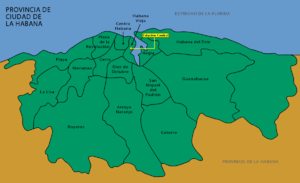Havana Central La Habana Central | |||||
|---|---|---|---|---|---|
| Ferrocarriles de Cuba (Inter-city & Commuter) | |||||
 Exterior facade of the station building | |||||
| General information | |||||
| Location | 401 Avenida de Bélgica Havana, Cuba | ||||
| Coordinates | 23°07′47″N 82°21′19″W / 23.129673°N 82.355286°W | ||||
| Owned by | Revolutionary government | ||||
| Platforms | Below-grade | ||||
| Tracks | 10 (covered) | ||||
| Connections | Metrobus, Omnibús Metropolitanos (OM), ASTRO (Inter-city) | ||||
| Construction | |||||
| Structure type | At-grade | ||||
| Platform levels | 4 | ||||
| Parking | yes | ||||
| Bicycle facilities | yes | ||||
| Accessible | Yes | ||||
| History | |||||
| Opened | 1912 | ||||
| Passengers | |||||
| 2009 | |||||
| |||||

Havana Central (Spanish: La Habana Central; the "Central Railway Station", Estación Central de Ferrocarriles) is the main railway terminal in Havana and the largest railway station in Cuba, is the hub of the rail system in the country. It serves for the arrival and departure of national and divisional commuter trains, and is home to the national railway company, Ferrocarriles Nacionales de Cuba (FFCC), the only intercity passenger rail transport operating in the Caribbean.[2]
The building is considered a national monument for its architectural and historical values[3] and is, along with the stations of Santiago, Camagüey and Santa Clara, a network's divisional headquarter.[4]
- ^ National Statistics Census of Cuba - Transportation (Page 6) Archived 2011-08-22 at the Wayback Machine
- ^ Railways of the World
- ^ (in Spanish) Cuba's National Heritage Site Archived 2014-02-21 at the Wayback Machine
- ^ See the File:Esquema ferrocarril cuba.png
